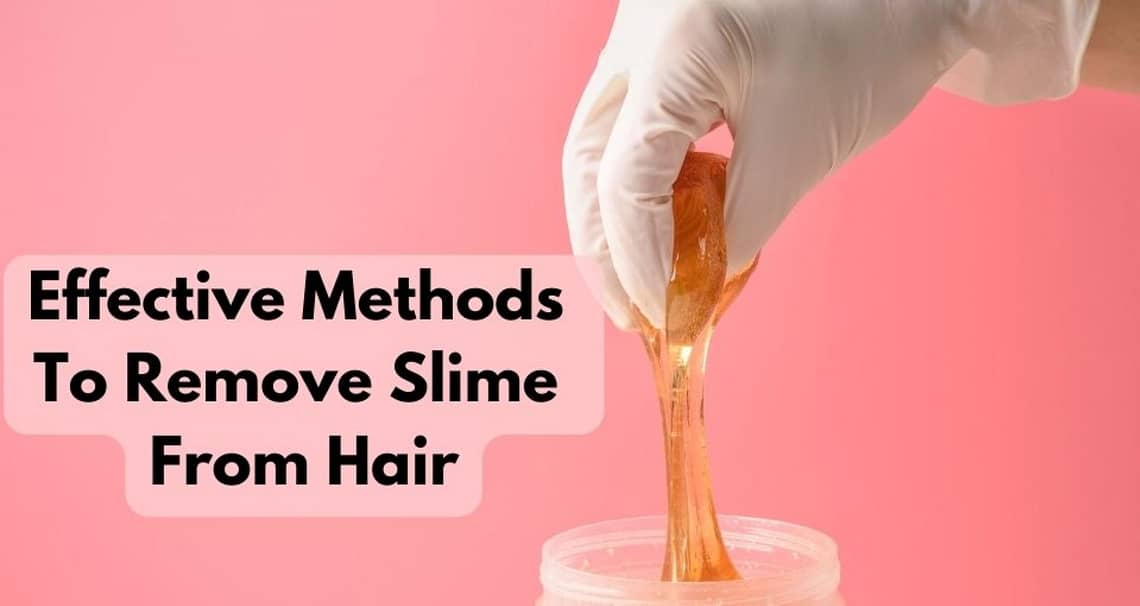Has your hair ever fallen prey to the sticky, gooey mess that is slime? Don’t worry, you’re not alone. Whether it’s a result of a playful prank or a messy mishap, dealing with slime in your hair can be quite a daunting task. But fear not, as we bring you a range of effective methods to tackle this hair-raising slime situation. From common household ingredients to smart hacks, we’ve got you covered. So, say goodbye to sticky strands and hello to hassle-free, slime-free hair!
Why Does Slime Get Stuck in Hair?
Properties of slime
Slime is a popular play material known for its stretchy and gooey consistency. It is typically made from a combination of glue, water, and a slime activator such as borax or contact lens solution. The sticky and adhesive nature of slime is what allows it to easily adhere to surfaces, including hair. Additionally, certain slime recipes may contain ingredients that further increase its stickiness, such as cornstarch or sugar.
Effects of slime on hair
When slime gets stuck in hair, it can cause several undesirable effects. The hair strands may become tangled, leading to difficulty in combing or brushing. Pulling or tugging the hair to remove the slime can result in breakage or damage to the hair shafts. The stickiness of slime can also attract dirt and debris, making the hair appear unkempt and dirty. In some cases, the chemicals present in certain slime recipes may cause irritation or scalp discomfort.
Prevention and Precautions
Keep hair tied up or covered
One of the simplest ways to prevent slime from getting stuck in hair is to keep the hair tied up or covered during slime play. Tying the hair in a ponytail, braid, or bun can minimize the chances of slime coming into contact with the hair strands. Alternatively, wearing a shower cap or a bandana can provide a protective barrier between the hair and the slime.
Read slime instructions carefully
When purchasing or making slime, it is important to read the instructions carefully. Some slime recipes may have specific recommendations for handling or use, which can help prevent issues such as excessive stickiness or difficulty in removing slime from surfaces. By following the instructions provided, you can minimize the risks associated with slime play.
Choose slime with non-toxic ingredients
Opting for slime made with non-toxic ingredients can be beneficial for both the hair and overall well-being. Non-toxic slime formulas are less likely to cause irritation or discomfort if they come into contact with the hair or scalp. Checking the ingredients list and selecting slime brands that prioritize safety can help reduce the potential negative effects of slime on the hair.
Initial Steps for Removing Slime
Avoid panic and patience
When faced with slime-stuck hair, it is important to remain calm and avoid panic. Panicking may lead to hasty and ineffective attempts to remove the slime, potentially causing more damage to the hair. Take a deep breath and approach the situation with patience, knowing that with the right techniques, the slime can be successfully removed.
Gently remove excess slime
Before proceeding to more extensive removal methods, start by gently removing any excess slime from the hair. Use your fingers or a fine-tooth comb to carefully loosen and dislodge the slime from the hair strands. Avoid pulling or tugging forcefully, as this can cause more entanglement and hair breakage.
Check for any discomfort or irritation
While removing the slime, pay attention to any signs of discomfort or irritation. If the scalp becomes red, itchy, or irritated, it may be necessary to seek medical advice. Certain slime ingredients or prolonged contact with the scalp can cause allergic reactions or chemical sensitivity in some individuals. Prioritize the health and well-being of the hair and scalp throughout the removal process.
Method 1: Using Warm Water and Soap
Materials needed
- Warm water
- Mild shampoo or liquid soap
- Towel
- Wide-tooth comb
Step 1: Wetting the slime
Start by wetting the affected hair with warm water. This can help loosen the slime and make it easier to remove. Ensure that the water is comfortably warm, but not too hot, to avoid scalding the scalp.
Step 2: Applying soap
Apply a small amount of mild shampoo or liquid soap to the areas with slime. Gently massage the soap into the hair, focusing on the areas where the slime is most concentrated. The soap acts as a lubricant, helping to further loosen the slime.
Step 3: Conditioning the hair
After removing the slime, apply a nourishing conditioner to the hair. Leave it on for a few minutes, then rinse thoroughly. This helps restore moisture and softness to the hair, counteracting any potential dryness caused by the soap.
Precautions to consider
- Ensure that the water temperature is comfortable and gentle on the scalp.
- Use a mild shampoo or liquid soap to avoid scalp irritation.
- Be gentle while massaging the soap into the hair to prevent tangles or further entanglement.

Method 2: Applying Oil or Conditioner
Materials needed
- Hair-friendly oil (such as coconut oil, olive oil, or baby oil)
- Clarifying shampoo or gentle cleanser
- Wide-tooth comb
Step 1: Applying oil or conditioner
Start by applying a generous amount of hair-friendly oil or conditioner to the affected areas. The oil or conditioner helps dissolve the slime and reduces its adhesive properties. Work the oil or conditioner into the hair, ensuring that all the slime-covered strands are thoroughly coated.
Step 2: Gentle detangling
Using a wide-tooth comb or your fingers, gently detangle the hair to remove any remaining slime. Start from the ends of the hair and work your way up to the roots, using slow and deliberate movements. Take your time and be patient to prevent further hair entanglement or breakage.
Step 3: Conditioning the hair
Apply a moisturizing conditioner to the hair after rinsing off the oil or conditioner. Allow the conditioner to sit for a few minutes before rinsing thoroughly. This helps restore hydration and nourishment to the hair, leaving it soft and manageable.
Precautions to consider
- Choose a hair-friendly oil or conditioner that suits your hair type and preferences.
- Avoid applying too much oil or conditioner, as excessive amounts can make the hair appear greasy.
- Be patient and gentle during the detangling process to avoid hair breakage or damage.
Also Check: Why Does Hair Get Greasy So Quickly?
Method 3: Freezing the Slime
Materials needed
- Ice pack or ice cubes
- Wide-tooth comb
- Mild shampoo or liquid soap
- Towel
Step 1: Applying ice pack or ice cubes
Take an ice pack or wrap some ice cubes in a towel. Gently press the cold pack or towel against the affected areas of the hair for a few minutes. The cold temperature helps harden the slime, making it easier to remove.
Step 2: Slowly breaking the slime
Once the slime has hardened, carefully and slowly break it into smaller pieces. Use your fingers or a wide-tooth comb to gently loosen and separate the slime from the hair strands. Take your time to minimize hair breakage or discomfort.
Step 3: Gentle detangling
After breaking the slime into smaller pieces, gently detangle the hair using a wide-tooth comb. Start from the ends of the hair and work your way up, using slow and deliberate movements. This helps remove the remaining slime and restore the hair’s smoothness.
Step 4: Conditioning the hair
Apply a moisturizing conditioner to the hair to replenish moisture and promote smoothness. Leave the conditioner on for a few minutes, then rinse thoroughly to achieve soft and manageable hair.
Precautions to consider
- Handle the cold pack or ice cubes with care to avoid direct contact with the skin.
- Be gentle when breaking the hardened slime to prevent hair breakage.
- Take your time while detangling to avoid causing discomfort or pain.
Method 4: Vinegar Solution
Materials needed
- White vinegar or apple cider vinegar
- Water
- Spray bottle
- Towel
- Mild shampoo or liquid soap
- Conditioner
Step 1: Preparing the vinegar solution
Mix equal parts white vinegar or apple cider vinegar with water in a spray bottle. Shake the mixture well to ensure it is thoroughly combined. The vinegar helps break down the slime and loosen its adhesive properties.
Step 2: Soaking the affected hair
Spray the vinegar solution onto the areas of hair with slime, ensuring that it is evenly distributed. Allow the vinegar solution to soak into the hair for a few minutes, allowing it to penetrate and break down the slime.
Step 3: Conditioning the hair
Apply a moisturizing conditioner to the hair after rinsing off the vinegar solution. Leave the conditioner on for a few minutes before rinsing thoroughly. This helps restore moisture and softness to the hair, counteracting any dryness caused by the vinegar.
Method 5: Using Commercial Slime Removers
Reading and following product instructions
When using commercial slime removers, it is crucial to read and follow the product instructions provided. Different products may have specific guidelines for their safe and effective use. Adhering to these instructions ensures optimal results and minimizes the risk of any adverse effects.
Testing the product on a small area
Before applying the slime remover to the entire head of hair, it is advisable to perform a patch test on a small, inconspicuous area. This helps determine if the product causes any unwanted reactions, such as scalp irritation or hair damage. If any adverse effects occur, discontinue use immediately.
Rinsing and conditioning the hair
Thoroughly rinse the hair with warm water after using the commercial slime remover. Ensure that all remnants of the slime remover and dissolved slime are completely washed away. Follow up with a moisturizing conditioner to restore hydration and minimize any potential drying effects of the remover.
Precautions with chemical-based removers
Chemical-based slime removers may contain strong ingredients that can cause scalp irritation if used incorrectly. It is important to use these products sparingly and as directed. If any discomfort or adverse reactions occur, discontinue use immediately and seek professional advice if necessary.
Preventing Slime from Getting into Hair
Hair protection options
To prevent slime from getting into the hair during playtime, consider using hair protection options such as headbands, shower caps, or hats.
Playing with slime in controlled areas
Designate a controlled and enclosed area for slime play. This helps contain the slime to a specific space, reducing the risk of accidental contact with the hair. By confining the play area, you can easily clean up any spilled or dropped slime without it coming into contact with the hair.
Choosing hair-friendly slime
When selecting slime for playtime, opt for hair-friendly options. Look for slime brands that prioritize non-toxic ingredients and provide information on their stickiness levels.
Conclusion
Importance of safe and effective slime removal
Slime getting stuck in hair can be a frustrating and challenging situation, but with the right methods, it can be successfully resolved. Prompt and proper removal techniques are crucial to prevent hair damage and discomfort. By understanding the properties taking preventive measures, you can minimize the chances of slime becoming entangled in your hair.
Follow the appropriate methods and precautions
When dealing with slime-stuck hair, it is important to stay calm, patient, and gentle. Follow the appropriate removal methods outlined above, tailoring them to your specific situation. Read and follow the instructions carefully, and prioritize the health and well-being of your hair and scalp throughout the entire process.





